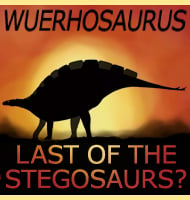In Depth
The skull of Bistahieversor has many features that are considered primitive for the tyrannosaurid group, but most importantly, a noticeable depth that is lacking in other, and later, tyrannosaurid species. This is significant because it was once thought that only the later and more advanced tyrannosaurids, like Tyrannosaurus itself, had deeper snouts. The fact that the fossil record can show us tyrannosaurid snouts that were deep in Bistahieversor, getting narrower in others like Gorgosaurus and Albertosaurus, and going deep again in Tyrannosaurus, suggests that skull depth was an evolutionary adaptation to predatory styles and prey animals, as opposed to tyrannosaurid advancement.
Increased skull depth is often taken as an indication for larger jaw muscles, in turn capable of inflicting significantly more bite force. The skull also features an extra opening above the orbital fenestra, which has considered to have been an air sac for reducing skull weight. This opening is absent from the juvenile specimen, suggesting that it was a sign of maturity. This also reinforces the weight reduction theory, as it would have helped to lighten the skull as it grew bigger, and heavier. Bistahieversor had around sixty-four teeth, a lot for a tyrannosaurid when you consider that Tyrannosaurus had fifty-four.
At roughly nine meters long, Bistahieversor would have been comparable to the tyrannosaurid Daspletosaurus in size, which was active in the Northern reaches of Campanian USA, while Bistahieversor was in the south. Bistahieversor was also joined by the tyrannosaurid Teratophoneus, another of its kind that seems to have been restricted to the Southern US even though it also lived during the Campanian.
Both Bistahieversor and Teratophoneus display more basal tyrannosaurid morphology, and both are known only from the southern area of what was once called Laramidia. This was the western half of North America that was separated from the eastern half by the Western Interior Seaway. Rising sea levels combined with mountain ranges being pushed up could have isolated the southern tyrannosaurids from the North, causing the retention of the more basal features seen in Bistahieversor, so late in the geological timescale.
Further Reading
– Bistahieversor sealeyi, gen. et sp. nov., a new tyrannosauroid from New Mexico and the origin of deep snouts in Tyrannosauroidea. – Journal of Vertebrate Paleontology. 30 (1). – Thomas D. Carr, Thomas E. Williamson – 2010. – Neurosensory and sinus evolution as tyrannosauroid dinosaurs developed giant size: insight from the endocranial anatomy of Bistahieversor sealeyi. – The Anatomical Record. – Matthew McKeown, Stephen L. Brusatte, Thomas E. Williamson, Julia A. Schwab, Thomas D. Carr, Ian B. Butler, Amy Muir, Katlin Schroeder, Michelle A. Espy, James F. Hunter, Adrian S. Losko, Ronald O. Nelson, D. Cort Gautier & Sven C. Vogel. – 2020.










